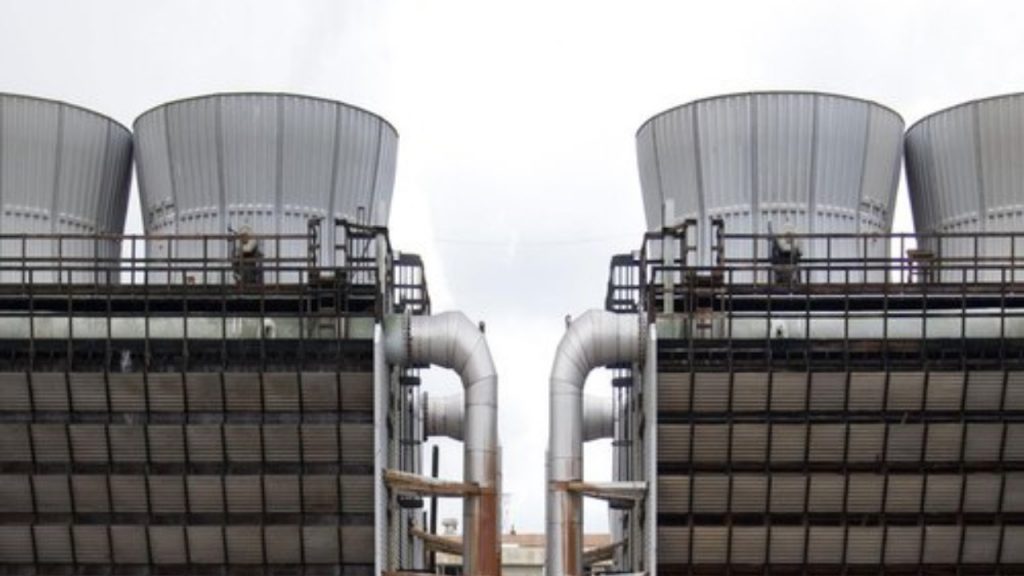Overview
The velocity and temperature of the water returning from the process determine the load on a cooling tower. The temperature of the cooling water that is returning to the process is the controllable variable. We then regulate the airflow through the tower, and which can then modify either by modifying the speed of variable-speed fans. We can also alter them by turning on and off a number of variable-speed fans.
A cooling tower’s work in a power plant is to remove the heat absorbed in the circulating water systems evaporatively.
The airflow entering the tower’s entrance determines its efficiency to a great extent. The performance of the cooling tower is harmed by turbulent airflow at the air intake. This limits power output, especially during hot summer months.
The preparation of food and beverages necessitates a wide temperature range. This requires the installation of efficient cooling systems to deal with the extra heat. A cooling tower is necessary to remove surplus heat from the system, but traditional designs require constant maintenance. This article shows how to make cooling towers more efficient.
How to Optimize Cooling Tower
Traditional fans use induction motors that spin at 1500 rpm and are coupled to a driveshaft, which is connected to a gearbox, which is then connected to the fan. Because there are so many moving parts, the system is prone to malfunctions. Additionally, gearbox maintenance is time demanding, and oil leaks are prevalent owing to the environment. Modern cooling fans require motors that we need to install directly on the fan and can withstand the conditions inside the cooling tower to combat this. We can replace many of these older motors with more energy-efficient permanent magnetic motors. This can be mounting directly on the fan. As a result, the number of parts in the system will be reducing, lowering the risk of failure. They’re also smaller than standard cooling tower motors, which means the system takes up less room.
Furthermore, we may use the fans to prevent freezing during the colder months of the year because the motors are reversible. This helps to enhance cooling towers by minimizing noise pollution. The improved efficiency of permanent magnetic motors, especially at partial loads, together with the drive’s variable speed control, assure quick operation of the fans at the needed speed, saving energy, decreasing CO2 footprint, and minimizing running costs.
More methods to optimize Cooling Tower
We can use the drives, such as ABB’s ACS880-01 industrial drives with permanent magnetic motors. We can use cooling tower application control programs to make this happen. This enables the industry to match the motor speed to the demand of the process. As a result, cooling towers will be able to operate for extended periods of time while requiring less maintenance. Overall, updating cooling tower systems can save a lot of money and provide a stable production platform that can help your company develop. Traditional cooling technologies, particularly cooling fan motors, are no longer sufficient to meet the system’s demands. The only way to boost output is to optimize processes by implementing new technologies.
Optimized controls
The cooling water temperature (Tctws) rises as the approach increases, as seen in Figure. The temperature differential between the process cooler and the process cooler (Tp – Tctws) is also minimized. The approach controller TDIC-1 throttles the air fan speed to keep the setpoint (SP-1) constant. A valve position controller calculates the optimal pump speed (VPC-4). This serves to minimize the need to add and remove the needed amount of water that is getting cooled inside the water area. This helps to reduce pressure drops at all of the plant’s cooling water valves. We then observe and update the data for the cost curves on a regular basis based on actual fan and pump running costs.
Temperatures of supply and return water that are optimal
The approach controller optimizes the temperature of the supply. When the water is at the most cost-effective temperature, it will be optimum. TDIC-1 regulates the cooling tower’s cooling water supply temperature. TDIC-2 is the range controller, and the optimum setpoint of SP-2 is used to set it. PDIC-3 detects the load and increases the pump speed if its output exceeds that of the range controllers. We require the external reset feedback on all TDIC-2, PDIC-3, and VPC-4 controllers. This guarantees that all users benefit from increased cooling while the system’s pressure loss is kept to a minimum. Increasing the setpoint reduces the safety margin while increasing energy conservation.
The optimization of cooling towers is typically only a small portion of the overall cooling system optimization in most industrial operations. The reason for this is because the cooling tower water temperature is too high. We use chillers in these situations to further lower the water temperature. Furthermore, optimizing the resulting chiller-tower combinations becomes both more difficult and profitable.
Bottom Line
A cooling tower system is one of the most energy-intensive systems. As a result, many industrial companies seek to make their cooling towers chill as much water as possible through evaporative processes while using as little electricity as possible.
Assess the cooling tower’s energy consumption, which mainly consists of fan and pump horsepower (HP). At the very least, ensure that the cooling tower fulfills ASHRAE 90.1 criteria in terms of HP per cooling tonne. Cooling towers only use a fraction of the horsepower available most of the time since they are mainly design to meet cold water requirements on the hottest, most humid days. Do you have any other cooling tower-related questions, comments, or suggestions for us? At Jateen Trading Co., you can obtain all of the services and products required for their upkeep and maintenance.
We, follow the best practices and guidance to keep and maintain your Cooling Towers. Please get in touch with us and inform us. Do you find this article interesting? Then please check out the rest of the blogs too.


